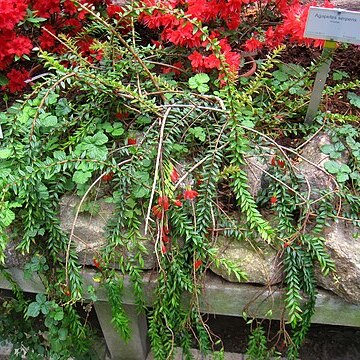Shrubs 40–60 cm tall. Rootstock tuberous. Twigs terete, 1–2 mm in diam., densely spreading glandular setose. Leaves crowded; petiole ca. 1 mm, glabrous; leaf blade pale green abaxially, deep green adaxially, narrowly ovate or ovate-oblong, 1.2–2 cm × 5–8 mm, leathery, abaxially smooth, adaxially drying transversely rugose, glabrous, secondary veins ca. 3 pairs, usually inconspicuous, base rounded, margin slightly recurved, serrate above middle, apex acute or obtuse, distinctly mucronulate. Inflorescences fasciculate, 1–3-flowered. Pedicel erect or pendulous, 0.7–2.5 cm, densely spreading glandular setose, slightly thicker at apex. Calyx tube 3.5–4 mm, 5-winged, along wings sparsely glandular setose; limb divided nearly to base; lobes ovate-triangular, 3.5–4.5 mm, glandular ciliate, apex acute or subobtuse. Corolla bright red, orange, or pinkish white, with dark red zig-zag bands, tubular, 1.2–2.8 cm, 5-angled, sparsely glandular; lobes recurved, triangular, 2–3(–6) mm. Filaments ca. 3 mm, glabrous; anthers ca. 1.9 cm, thecae papillate, base apiculate, tubules to 2 × as long as thecae, without spurs. Berry obovoid, 5-winged, ca. 6 mm in diam.; persistent calyx lobes enlarged. Fl. May–Jun, fr. May–Nov.
More
A shrub which grows attached to other plants. The branches droop downwards. They grow from a large woody tuber. It is about 1 m high. The stems are bristly and brown. The leaves have short stalks. Leaves are 0.8-2 cm long by 0.8-0.4 cm wide. They are oval and thick and the edges are curved. The flowers are red and like tubes. Each flower has 5 distinct angles and a pattern of V shaped bars of darker red. The fruit is a berry. It has five wings.

